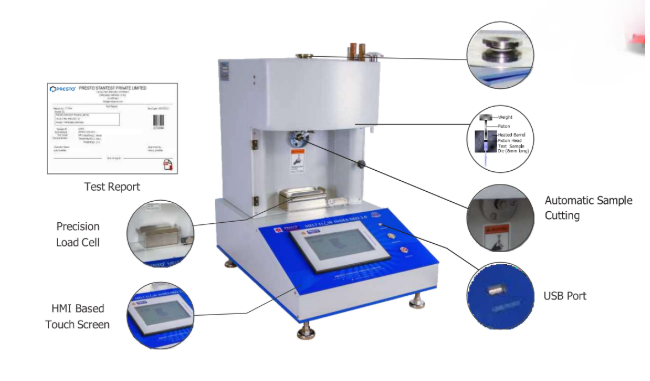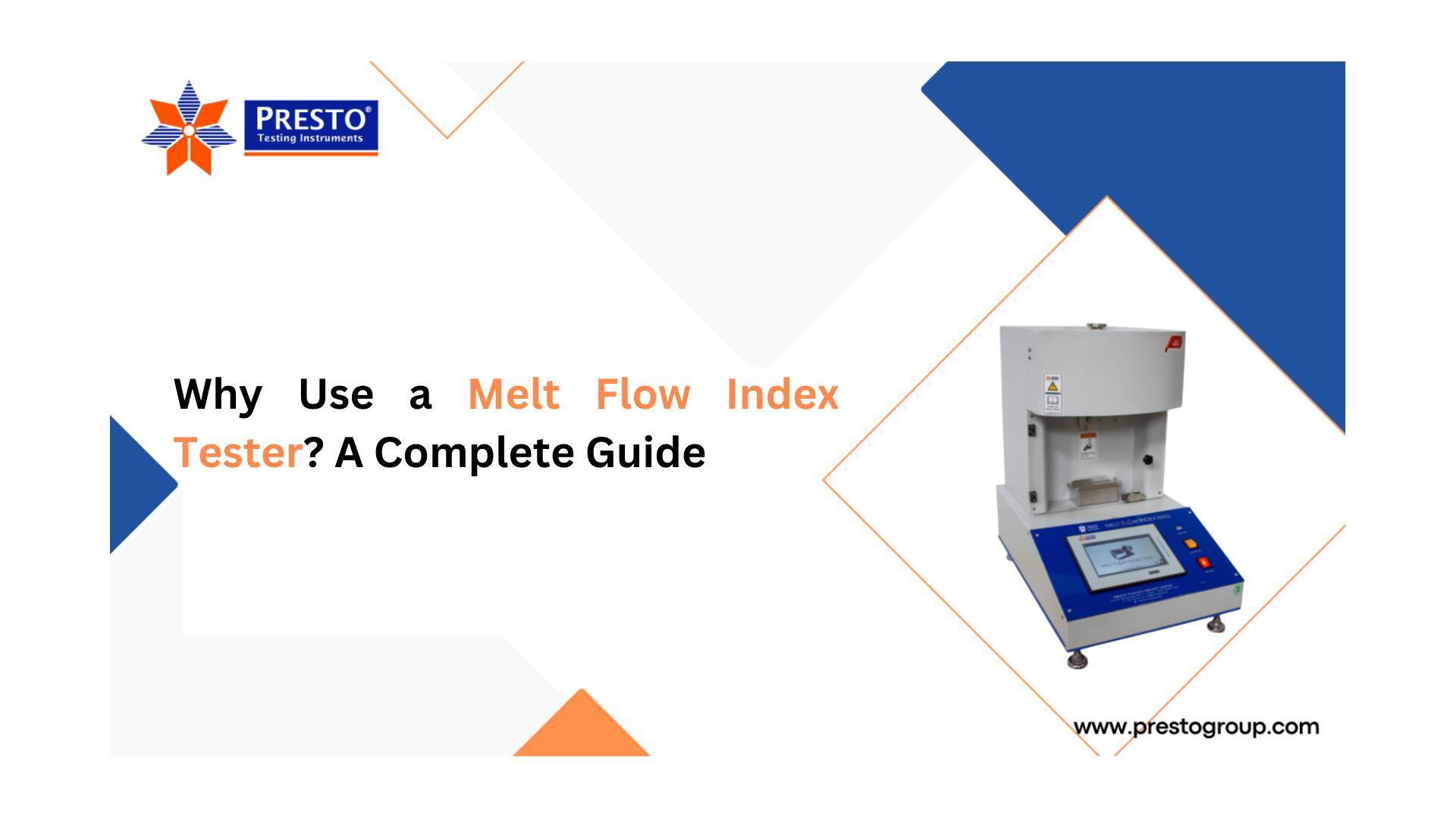In the polymer industry, precise material characterisation holds major importance as it ensures consistency and quality. The melt Flow Index (MFI) test is one of the most importantly performed tests in the polymer industry which is performed using an MFI tester or a melt indexer/melt flow index machine. This gives important information regarding the flow behaviour of thermoplastics, thereby allowing manufacturers to determine uniformity and predict behaviour under processing.
This blog explores the importance of MFI testing, its applications, and best practices for accurate results, meeting the standards set by the industry.
Importance of MFI Testing in Polymer Quality Control
The MFI test is one of the widely used methods by the plastics industry to express the ease of flow of a thermoplastic polymer melt in controlled conditions. MFI machine data helps manufacturers maintain quality standards, optimize their production processes, and select the materials to be suitable for a certain application.
1. MFI Testing and Quality Control:- This is the reason why MFI testing is especially vital for quality control because:
- It gives batch-to-batch consistency of polymer flow properties.
- It enables the detection of material degradation or contamination that may influence processing.
- It offers a convenient and consistent estimate of polymer behaviour at moulding or extrusion.
Because the melt index tester measures polymer flow under specific conditions, it cannot predict all material properties. It is an excellent tool for screening conditions for variations in polymer structure that might affect the processing and performance of products.
2. Understanding MFI Test Methodology:- MFI testing is performed on an MFI testing machine under standardized conditions, which are usually defined by ASTM D1238 or ISO 1133. The procedure includes the following steps:
- Preheating the polymer in the barrel of the melt flow tester at a specified temperature.
- A standard weight is applied to force the molten polymer through a die of fixed diameter.
3. Measuring the mass or volume of the extruded material over a definite time in order to obtain the melt flow rate, often quoted in units of g/10 min.
Conditions: temperature, applied load, and time—must all be carefully controlled to ensure accurate, repeatable results.
 Meaning of MFI Results
Meaning of MFI Results
The MFI gives a number representing the flowability of the polymer, but it should be appreciated that:
- A higher MFI value means lower molecular weight and easier flow, which makes the polymer suitable for injection moulding.
- A lower MFI value indicates higher molecular weight and higher melt strength, which is more suitable for extrusion applications.
- The test is not a direct measure of viscosity, but it gives an idea about the processing behaviour of the polymer when correlated with other rheological tests.
Factors Affecting MFI Test Results
Several variables may affect the accuracy of MFI tests, resulting in inconsistency in polymer characterization:
1. Polymer Properties and Molecular Structure
The molecular weight distribution and branching structure of a polymer significantly affect the measured melt flow index.
Changes in composition, additives, and fillers can alter flow behaviour, thus requiring careful test standardization.
2. Test Conditions and Equipment Variations
Temperature fluctuations in the melt chamber can lead to inconsistent results.
- Variations in die geometry and piston motion from one melt flow index machine to another may contribute to the variation.
- Handling by the operator and preconditioning of the material also impact repeatability.
- The use of standardized MFI testing machines with precise temperature control and automated weight application is suggested to minimize human error.
Advanced Techniques:- Flow Rate Ratio (FRR) for Improved Material Characterization
In addition, where a single value of MFI is inadequate, a manufacturer may use several test conditions in the calculation of the Flow Rate Ratio (FRR):
FRR= MFI at higher load/MFI at lower load
This ratio shows more sensitivity to a polymer's shear-thinning behaviour, especially in:
mul-ti-layer film extru-sion blow mold-ing injection mold-ing where tight flow regulation is necessary This implies that process stability is enhanced with an application of FRR measurements.
Best Practices for Accurate MFI Testing
Industry best practices to ensure reliable and repeatable results in a melt flow tester are as follows:
1. Standardize Test Conditions
- Comply with ASTM D1238 or ISO 1133 testing protocols.
- Test temperature, piston weight, and preheating time must be consistent.
2. Use High-Precision Equipment
- Invest in an automated MFI testing machine to reduce human error.
- Calibrate instruments regularly to maintain accuracy.
3. Verify Sample Preparation
- Polymer samples should be clean, dry, and free of contaminants.
- Condition samples at the required temperature before testing.
4. Troubleshoot Discrepancies
If inconsistent results occur, consult the troubleshooting guide provided in ASTM D1238 (Appendix X2).
- Check for die wear, temperature variations, or operator errors.
By implementing these best practices, manufacturers can enhance material consistency, reduce production downtime, and improve product performance.
Choosing the Right MFI Tester for Your Needs
When selecting a melt index tester, consider the following factors:
- Automated vs. Manual: Reduces human errors and allows more reproducibility.
- Temperature: Precision is Very critical to obtain the correct characterization of polymer
- Multiple Load Capability: Capability for calculation of FRR that allows analysis for complex material systems
- Standards Compliance: Meets ASTM D1238 and ISO 1133 requirements
- Ease of Operation: A simple user interface promotes better workflow.
Digital control with melt flow index machines is designed with real-time data logging, and multi-condition testing ideal for polymer labs today.
FAQs
1. How is MFI different from viscosity?
MFI measures polymer flow under specific conditions, while viscosity provides a broader characterization of flow resistance across varying shear rates.
2. Why does my MFI value vary between batches?
Variations in molecular weight, additives, and processing conditions can cause batch-to-batch fluctuations. Regular calibration and process control help maintain consistency.
3. How does MFI impact plastic product performance?
A higher MFI will yield easier flow and is thus used for injection moulding, whereas a lower MFI will ensure better melt strength and is used for extrusion and film production.
4. Does MFI testing predict final product quality?
Though MFI does not determine the mechanical properties alone, it is an important quality control parameter if correlated with other tests such as tensile strength and impact resistance.
5. How often do I need to calibrate my MFI testing machine?
Regular calibration is recommended monthly or after significant usage to ensure accuracy and compliance with industry standards.
Improving Quality with Reliable MFI Testing.
Reduce production defects and waste:- As polymer applications continue to be more demanding, advanced MFI testing machines with multi-condition capabilities will play a critical role in optimizing material selection and performance.
For industries that require precision, reliability, and compliance, selecting the right melt flow index machine is crucial to maintaining high-quality production standards.
Get the best Melt Flow Tester Price at Presto! Ensure accurate polymer flow measurement with our high-quality testing instruments. Contact us at +91 9210 903 903 or info@prestogroup.com today!
